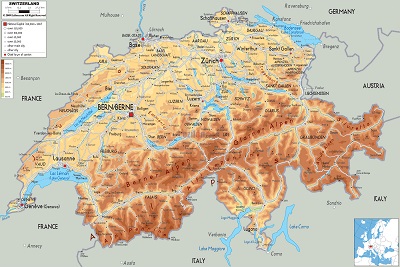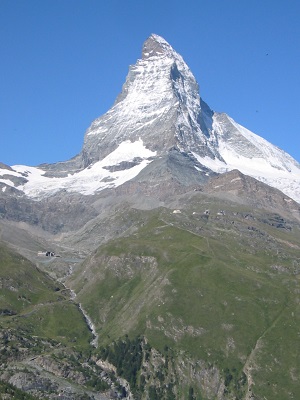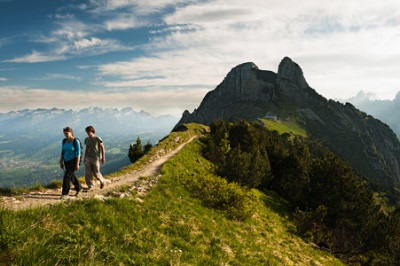- Trips
- Tour Calendar
- About Our Tours
- Plan a Trip
- Book a Trip
- About Us
- Contact Us



The Alps, the mountain range that arcs its way across much of Europe, is the youngest, largest, highest, and most densely populated mountain range in Europe. This mountain range was formed about 45 million years ago. The Alps covers most of Switzerland and Liechtenstein and extends into France, Germany, Austria, Italy, Croatia, Bosnia and Herzegovina, Montenegro, Albania, and Slovenia. The total area of the Alps is 192,753 square kilometers, of which only 14% is in Switzerland, however most of the iconic peaks classic alpine scenery of the Alps is in Switzerland, making it the one European country people most closely associate with the Alps.
The mountainous alpine region of Switzerland is referred to as the Swiss Alps. In Switzerland’s four national languages, the Swiss Alps are known as Schweizer Alpen (German), Alpes suisses (French), Alpi svizzere (Italian), and Alps svizras (Romansch). The Swiss Alps are one of the three main geographic regions of Switzerland, the other two being the Swiss Plateau and the Jura Mountains. The portion of the Alps lying within Switzerland is sometimes referred to as the Central Alps, but more commonly known as the Swiss Alps. The Alps cover 65% of Switzerland's total land mass, making it one of the most mountainous of European countries. Although the Swiss Alps cover most of Switzerland, it is a lesser populated region of the country, although it is popular among outdoor enthusiasts for hiking and trekking tours. Some of the most popular long-distance treks in Europe lead through the Swiss Alps
 Highest Peaks in the Alps
Highest Peaks in the AlpsAlmost all the highest peaks of the Alps are located within Switzerland. These highest peaks are Dufourspitze, or Monte Rosa as it is widely known (4,634 m), the Dom, which is the highest peak lying entirely within Switzerland (4,545 m), the Liskamm (4,527 m), the Weisshorn (4,506 m) and the Matterhorn (4,478 m). The highest peak in the Alps, Mont Blanc (4,807 m), is located on the French-Italian border, although it’s eastern flanks are located within Switzerland.
Of the 82, 4,000 meter peaks in the Alps, 48 are in Switzerland, and almost all the remaining 34 are within 20 kilometers of the Swiss border. The major subranges of the Swiss Alps are:
Of the total glaciated area of the Alps, 44% is located in Switzerland. The glaciers of the Swiss Alps cover an area of 1,220 square kilometers—3% of Switzerland’s territory. The highest concentration of glaciers in the Alps is in the Jungfrau Region of the Bernese Alps. The Greater Aletsch Glacier in the Bernese Alps is the largest and longest glacier in the Alps, with a maximum depth of 900 meters. Along with the Fiescher and Aar Glaciers, the surrounding Jungfrau Region became a UNESCO World Heritage Site in 2001.
 Tourism in the Swiss Alps
Tourism in the Swiss AlpsTourism in the Swiss Alps emerged during the Golden Age of Alpine Mountaineering as early alpinists, mostly from Britain and accompanied by local guides made the first ascents of the highest peaks of the Alps (Jungfrau in 1811, Wetterhorn in 1852, Monte Rosa in 1855, Dom in 1858, Matterhorn in 1865, and Weisshorn in 1861).
Thomas Cook organized the world’s first international group tour by bringing a group of travelers to Switzerland in 1863. British tourists who first came to St Moritz in 1865 are considered the start of winter tourism in the Alps.
The construction of tourist facilities commenced in the mid-nineteenth century with the building of hotels and mountain huts (creation of the Swiss Alpine Club in 1863) and the opening of mountain train lines on (Rigi in 1873, Mt. Pilatus in 1889, Gornergrat in 1898). The Jungfraubahn opened in 1912; it tunnels through the Eiger and leads to the highest railway station in Europe, the Jungfraujoch.
The crossing of the Alps has been an historic challenge for European merchants, armies, and travelers. The high passes, while an obstacle to travel, have also provided security and protection to Switzerland. Over the past 150 years, Switzerland has continued to improve its transalpine transportation routes. Today, rail travel in the Alps is an important link for trans-Alpine trade, and also for tourism and scenic rail tours. It began in 1882, by building the Gotthard Rail Tunnel to open a north-south rail route between Italy and northern Switzerland, and into Germany and Austria. In 1906 the Simplon Tunnel connected the Italy with the Rhone Valley. In 2007, Lötschberg Base Tunnel was completed to provide a direct route through the Bernese Alps. The 57-km long Gotthard Base Tunnel which opened in 2016, now provides a direct flat rail link through the Alps. This tunnel is the world’s longest and will eventually shave 45 minutes off the travel time between Zurich and Milan while increasing capacity, allowing high-speed rail, and providing greater efficiency in transalpine travel and trade.